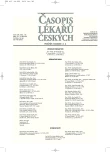-
Medical journals
- Career
Effect of Surgical Treatment of Atrial Fibrillation on the Attainment and Maintenance of Sinus Rhythm in Patients Undergoing Concomitant Cardiac Surgery – Short-term Results
Authors: M. Kolek; R. Brát
Authors‘ workplace: Kardiochirurgické centrum FN, Ostrava
Published in: Čas. Lék. čes. 2007; 146: 383-392
Category: Original Article
Overview
Background.
Atrial fibrillation is the most frequent sustained arrhythmia. It is associated with higher morbidity and mortality of patients. Cryoablation was introduced to the current practise in cardiac surgery as a non – pharmacological method of therapy of atrial fibrillation. The aim of the study was to assess the effect of surgical ablation of atrial fibrillation on the attainment and maintenance of sinus rhythm in patients undergoing concomitant cardiac surgery.Methods and Results.
Ninety four consecutive patients with atrial fibrillation (paroxysmal, persistent or permanent) were followed up prospectivelly. The mean age was 67.8 years; there were 39 (41.5 %) women in the study group. Forty two patients (44.7 %) had paroxysmal or persistent atrial fibrillation and 52 (55.3 %) of them had permanent atrial fibrillation before surgery. Patients with permanent atrial fibrillation had significantly bigger preoperative left atrial diameter (51.2 versus 46.6 mm) and more severe tricuspid regurgitation (grade 2.3/4 versus grade 1.4/4) compared to the group with paroxysmal and persistent atrial fibrillation. Mitral valve surgery was significantly more frequent in patients with permanent atrial fibrillation too. Operations were performed between January 2005 and July 2006 using flexible argon-based cryoablative device. Sinus rhythm was achieved statistically significantly more frequently in patients with preoperative paroxysmal and persistent atrial fibrillation in comparison with patients with permanent atrial fibrillation – at discharge, 1, 3.5 and 6 months after operation (90.5–96.3 % versus 50–65.9 %). At 12 months it was only statistical trend (84.6 % versus 63.3 %). Kaplan–Meier vyvianalysis demonstrated a 79.4 % freedom from atrial fibrillation at 12 months. Preoperative atrial size and duration of atrial fibrillation were the most significant negative predictors of maintenance of sinus rhythm. Four patients (9.3 %) required postoperative permanent pacemaker placement. Ischemic stroke occured in 5 (5.3 %) patients. Thirty-day motality was 12.9 % (12 patients).Conclusions.
Perioperative ablation of atrial fibrillation using cryoenergy is effective therapeutic method for restoring and maintenance of sinus rhythm in relatively high proportion of patients. The most significant predictors of late recurrence are preoperative atrial size and duration of atrial fibrillation. This non – pharmacological method should be routinely used in patients undergoing concomitant cardiac surgery.Key words:
atrial fibrillation, maze procedure, cryoablation, arrhythmia surgery.
Labels
Addictology Allergology and clinical immunology Angiology Audiology Clinical biochemistry Dermatology & STDs Paediatric gastroenterology Paediatric surgery Paediatric cardiology Paediatric neurology Paediatric ENT Paediatric psychiatry Paediatric rheumatology Diabetology Pharmacy Vascular surgery Pain management Dental Hygienist
Article was published inJournal of Czech Physicians

-
All articles in this issue
- Decompressive Craniectomy in the Treatment of Posttraumatic Edema and the Contribution of new Diagnostic Methods
- Milestones of Cardiovascular Pharmacotherapy: II. Digitalis
- Perioperative Betablockade
- Adjuvant Chemotherapy in the Treatment of Non-small Cell Lung Cancer
- Phytosterols as a Functional Food
- Genotype – Disease Association and Possibility to Reveal Environmentally Modifiable Disease Causes: The Use of Mendelian Randomization Principle
- How to Continue in the Treatment of Tuberculosis in the Czech Republic?
- Factors Modulating Parameters of Cholesterol Homeostasis in the Metabolic Syndrome
- Relation Between Alcohol Intake and Some Metabolic and Cardiovascular Risk Factors in the Healthy Men
- Practical Aspects and Clinical Value of t(14;18) Monitoring in Peripheral Blood of the Follicular Lymphoma Patients
- Effect of Surgical Treatment of Atrial Fibrillation on the Attainment and Maintenance of Sinus Rhythm in Patients Undergoing Concomitant Cardiac Surgery – Short-term Results
- The Use of Thrombelastography in Evaluation of Coagulation in Females with Physiological or Pathological Gravidity
- The Use of Paracetamol in Children –Benefits and Risks
- Indication to Occlusion of Patent Foramen Ovale in Patient with Pulmonary Hypertension after a Cardioembolic Stroke
- Journal of Czech Physicians
- Journal archive
- Current issue
- Online only
- About the journal
Most read in this issue- Adjuvant Chemotherapy in the Treatment of Non-small Cell Lung Cancer
- Indication to Occlusion of Patent Foramen Ovale in Patient with Pulmonary Hypertension after a Cardioembolic Stroke
- Phytosterols as a Functional Food
- The Use of Paracetamol in Children –Benefits and Risks
Login#ADS_BOTTOM_SCRIPTS#Forgotten passwordEnter the email address that you registered with. We will send you instructions on how to set a new password.
- Career

